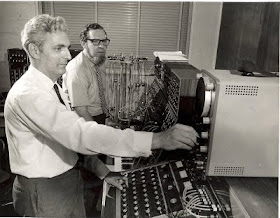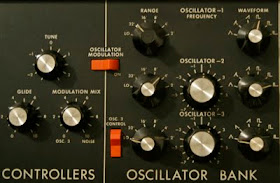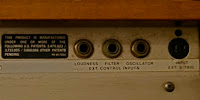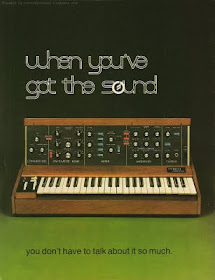
Herbert Arnold Deutsch nasceu no dia 09 de fevereiro de 1932 em Baldwin, Nova York. Ele e sua mãe perceberam muito cedo que a música teria uma importância muito grande na vida de Herb, então ele começou a ter aulas de piano aos 4 anos. Aos 11 anos resolveu tocar trompete, influenciado pelo jazz. Tocou em bandas durante todo o colegial e na faculdade. Depois da formatura, ele entrou em uma banda do exército dos EUA (Herb teve o músico de jazz Wayne Shorter como companheiro de banda durante este período), continuou a estudar, graduou-se em duas faculdades de música e, no início dos anos anos 60, tornou-se professor na Hofstra University, onde ele ainda trabalha, há mais de 50 anos.
 Em 1963 Herb Deutsch conheceu Robert Moog em uma conferência da NYSSMA (New York State Music School Association) em Rochester, NY. No ano anterior Herb havia construído um theremin modelo Melodia, a partir de um artigo escrito por Robert Moog para a revista “Electronics World", no qual Bob explicava passo a passo como montar o theremin e este foi o assunto inicial da conversa entre os dois. As idéias evoluíram muito rapidamente até que ambos decidiram trabalhar juntos no projeto da construção de um sintetizador de sons, com base nos princípios de voltagem controlada, que já vinham sendo desenvolvidos por Bob. Em 1964 eles projetaram e montaram o protótipo do primeiro sintetizador Moog e foi Herb quem, entre outras coisas, insistiu na idéia de utilizar um teclado semelhante ao de um piano, pois seria mais prático para os compositores e também ajudaria a aumentar as vendas do novo instrumento. E como ajudou! Em 1968, Wendy Carlos gravou o primeiro álbum de música clássica executado exclusivamente no sintetizador Moog ("Switched-on Bach") e isto não só impulsionou as vendas do instrumento como também fez com que MOOG se transformasse em sinônimo de modernidade e mudasse toda a história da música.
Em 1963 Herb Deutsch conheceu Robert Moog em uma conferência da NYSSMA (New York State Music School Association) em Rochester, NY. No ano anterior Herb havia construído um theremin modelo Melodia, a partir de um artigo escrito por Robert Moog para a revista “Electronics World", no qual Bob explicava passo a passo como montar o theremin e este foi o assunto inicial da conversa entre os dois. As idéias evoluíram muito rapidamente até que ambos decidiram trabalhar juntos no projeto da construção de um sintetizador de sons, com base nos princípios de voltagem controlada, que já vinham sendo desenvolvidos por Bob. Em 1964 eles projetaram e montaram o protótipo do primeiro sintetizador Moog e foi Herb quem, entre outras coisas, insistiu na idéia de utilizar um teclado semelhante ao de um piano, pois seria mais prático para os compositores e também ajudaria a aumentar as vendas do novo instrumento. E como ajudou! Em 1968, Wendy Carlos gravou o primeiro álbum de música clássica executado exclusivamente no sintetizador Moog ("Switched-on Bach") e isto não só impulsionou as vendas do instrumento como também fez com que MOOG se transformasse em sinônimo de modernidade e mudasse toda a história da música. Herb não só trabalhou ativamente com Bob Moog na invenção e desenvolvimento do instrumento como também foi um dos principais artistas a utilizar um equipamento destes, especialmente nos primeiros anos do sintetizador Moog. Ele compôs a primeira música de todos os tempos feita em um Moog ("Jazz images, worksong and Blues", 1964), realizou o primeiro concerto utilizando o equipamento ao vivo (com o "NY Improvisation Quartet" no Town Hall, NY, em setembro de 1965) e também conduziu e tocou com o seu quarteto no famoso concerto "Jazz in the garden" no MoMA (Museu de Arte Moderna, Nova York, em 28 de agosto de 1969), no qual foram utilizados pela primeira vez quatro sintetizadores modulares Moog ao mesmo tempo no palco. Nos anos 70, Herb escreveu algumas músicas na área do jazz-rock e uma de suas composições mais conhecidas deste periodo é "Lost your number", baseada em um número de telefone (cada nota tocada no tema principal corresponde a um dígito do número de telefone!).
Herb não só trabalhou ativamente com Bob Moog na invenção e desenvolvimento do instrumento como também foi um dos principais artistas a utilizar um equipamento destes, especialmente nos primeiros anos do sintetizador Moog. Ele compôs a primeira música de todos os tempos feita em um Moog ("Jazz images, worksong and Blues", 1964), realizou o primeiro concerto utilizando o equipamento ao vivo (com o "NY Improvisation Quartet" no Town Hall, NY, em setembro de 1965) e também conduziu e tocou com o seu quarteto no famoso concerto "Jazz in the garden" no MoMA (Museu de Arte Moderna, Nova York, em 28 de agosto de 1969), no qual foram utilizados pela primeira vez quatro sintetizadores modulares Moog ao mesmo tempo no palco. Nos anos 70, Herb escreveu algumas músicas na área do jazz-rock e uma de suas composições mais conhecidas deste periodo é "Lost your number", baseada em um número de telefone (cada nota tocada no tema principal corresponde a um dígito do número de telefone!).
 Paralelamente à sua carreira como compositor e ao seu trabalho como educador musical na Hofstra, Herb lecionou em várias outras instituições. Entre 1979 e 1983 ele trabalhou como diretor de marketing e vendas da Moog Music (foi ele quem desenvolveu e escreveu o manual do sintetizador Moog Opus 3 - lançado em 1980 - e também escreveu o manual do sintetizador Moog Rogue - lançado em 1981 – e do Moog Vocoder - lançado em 1979). Em 1972, Herb fundou (com a compositora Marga Richter) a Long Island Composer’s Alliance, um dos mais antigos coletivos de compositores dos Estados Unidos (Herb é o atual presidente da L.I.C.A.).
Paralelamente à sua carreira como compositor e ao seu trabalho como educador musical na Hofstra, Herb lecionou em várias outras instituições. Entre 1979 e 1983 ele trabalhou como diretor de marketing e vendas da Moog Music (foi ele quem desenvolveu e escreveu o manual do sintetizador Moog Opus 3 - lançado em 1980 - e também escreveu o manual do sintetizador Moog Rogue - lançado em 1981 – e do Moog Vocoder - lançado em 1979). Em 1972, Herb fundou (com a compositora Marga Richter) a Long Island Composer’s Alliance, um dos mais antigos coletivos de compositores dos Estados Unidos (Herb é o atual presidente da L.I.C.A.).Entrei em contato com Herb Deutsch pela primeira vez há cerca de um ano, para verificar sobre as possibilidades de trazê-lo ao Brasil para palestras. E, obviamente, eu queria entrar em contato com um dos meus grandes super-heróis. Meus amigos Michelle Moog-Koussa (filha de Robert Moog e presidente da Bob Moog Foundation) e Brian Kehew (grande músico, produtor e escritor que é atualmente o arquivista histórico da Moog Bob Foundation) me colocaram em contato com Herb pela primeira vez e, desde então, toda vez que eu envio um e-mail ele me responde gentilmente, assim que sua vida atribulada permite. Fiz essa entrevista com Herb por e-mail e eu ainda procuro uma boa oportunidade para trazê-lo ao Brasil para palestrar. E espero conseguir com que isso aconteça em breve!!!
Bem, vamos à entrevista!

ASTRONAUTA – Herb, eu li em algum lugar que você começou a estudar música muito cedo, ainda na infância. Também li que o seu primeiro instrumento (ou o principal) foi o trompete, pelo menos naquela época. Como o seu interesse pelo theremin - quando você já estava com 30 anos de idade - e, posteriormente, pelos sintetizadores influenciou sua música a partir desse momento (início dos anos 60)? Seus conceitos sobre música mudaram depois da entrada desses novos equipamentos eletrônicos na sua vida ou as novas possibilidades abertas por eles foram adicionados aos conceitos que você já tinha sobre a música?
HERB - Comecei meus estudos de música aos 4 anos de idade, tocando piano. Quando eu tinha 11 anos comecei a ouvir jazz e resolvi tocar trompete. Na escola e mesmo mais tarde, em uma banda do exército dos EUA, eu era trompetista. Mesmo quando eu compus "Jazz Images", usando o Moog pela primeira vez, eu escrevi para um solista de jazz tocando piano e trompete.
ASTRONAUTA – Segundo me consta, entre suas principais contribuições para a invenção do sintetizador Moog está o fato de você ter sugerido a Robert Moog que utilizasse um teclado no sintetizador. Você também sugeriu a ele que o sintetizador Moog deveria ter controles de "attack" e "decay" (posteriormente chamado de "Envelope Generator"). Existe também um fato curioso sobre a criação do "Envelope Generator" - a famosa história que, durante uma conversa entre você e Bob sobre o assunto, ele pediu para você atravessar a rua e comprar uma campainha em uma loja de ferragens e, quando você voltou, em cerca de meia hora Bob ja tinha um "Envelope Generator" praticamente pronto. Naqueles primeiros dias você tinha contato diário com Robert Moog ou pelo menos ia com freqüência à oficina dele? Como era este lugar e onde ficava esta oficina onde vocês desenvolveram suas idéias iniciais para o novo instrumento?
 HERB - Durante o desenvolvimento do primeiro protótipo do sintetizador eu fiquei acampado em Trumansburg, NY, em um acampamento estadual com minha esposa e minha filha pequena e nós ficavamos todos os dias, durante quase três semanas, com Bob na sua loja e estúdio. Para deixar claro, a campainha foi o primeiro "trigger" para acionar o “Envelope Generator”. Este conceito tornou-se o padrão de “trigger pulse”, utilizado em todos os sintetizadores analógicos daquela época.
HERB - Durante o desenvolvimento do primeiro protótipo do sintetizador eu fiquei acampado em Trumansburg, NY, em um acampamento estadual com minha esposa e minha filha pequena e nós ficavamos todos os dias, durante quase três semanas, com Bob na sua loja e estúdio. Para deixar claro, a campainha foi o primeiro "trigger" para acionar o “Envelope Generator”. Este conceito tornou-se o padrão de “trigger pulse”, utilizado em todos os sintetizadores analógicos daquela época.ASTRONAUTA – Além de estar presente e trabalhando com Robert Moog quando ele dava seus primeiros passos na invenção do sintetizador Moog, Herb Deutsch é responsável por, pelo menos, três momentos memoráveis no início, quando tudo ainda era novidade e ainda estava em fase de testes: a primeira composição feita com um sintetizador Moog (a peça "Jazz images, worksong and blues", escrita no outono de 1964); a primeira utilização de um Moog Modular ao vivo (no Town Hall, NY, em setembro de 1965, com o "NY Improvisation Quartet") e o concerto "Jazz in the garden" (realizado no MoMA, em New York, no dia 28 de agosto de 1969, no qual foram utilizados quatro sintetizadores modulares Moog simultaneamente). Quais são as suas memórias sobre esses fatos? Existem fotografias ou filmagens dos dois concertos em algum lugar?
HERB - O “NY Improvisation Quartet” realizou o primeiro concerto real utilizando o sintetizador Moog modular em setembro de 1965. Nós executamos obras minhas e também a peça "Refrain Fur drei Spieler", de Stockhausen (sem o Moog Modular nesta peça). O concerto de setembro, foi de grande interesse para os críticos, mas foi realizado exatamente durante uma greve dos trabalhadores do jornal de NY, então nunca foi resenhado, exceto por uma estação de radio que elogiou muito. O concerto no Museu de Arte Moderna, que aconteceu em agosto de 1969, foi um evento emocionante e espetacular para milhares de fãs, porém bem menos espetacular para os músicos. Os quatro sintetizadores modulares não estavam concluídos até um dia antes do concerto e tiveram que ser levados às pressas para o centro de NY e consertados em um hotel. Isso fez com que o único ensaio de verdade fosse feito somente na noite anterior ao concerto, com 8 ou 10 pessoas tocando com instrumentos nos quais eles nunca haviam encostado e sequer sabiam como operar! Eu tinha reunido um quarteto de jazz que incluia o grande pianista de jazz Hank Jones. Ele se apresentou com um instrumento que foi praticamente empurrado para ele. A outra banda era constituída por artistas do mundo do rock, com mais liberdade. Como todos sabem, o público estava realmente muito chapado, alto e animado. As apresentações foram tão boas quanto poderiamos esperar e o final acabou por se tornar um sucesso absoluto. No auge de uma improvisação livre (como toda a noite estava sendo) uma das pessoas da platéia, que estava tentando tirar uma fotografia pelo que fiquei sabendo, pisou no único cabo de força e desligou toda a iluminação e sonorização, deixando todos os presentes na escuridão. Foi espetacular! Os comentários, no entanto, não foram muito generosos com nenhum de nós. Eu posso incluir uma foto muito rara desta noite, se eu conseguir localizá-la.
ASTRONAUTA - Eu acho que o sintetizador Moog é uma das maiores invenções da humanidade. Também acho que a tecnologia utilizada nos sintetizadores analógicos foi pouco explorada em comparação com as possibilidades que poderiam ter sido levadas adiante. Nos anos 80, com o surgimento e popularização dos instrumentos digitais, os sintetizadores analógicos foram perdendo terreno e levou quase 20 anos até que Robert Moog conseguisse retomar os direitos de utilizar novamente o nome "Moog" e, a partir dai, o instrumento voltou a ser popular. Como você vê, tendo participado ativamente do nascimento do sintetizador Moog, este "renascimento" da fábrica e a crescente popularidade da marca Moog novamente?
HERB – Eu fico muito satisfeito com o trabalho que tem sido feito pela nova Moog Music Company. Eles mantiveram as idéias musicais dos instrumentos originais, eles mantiveram o amor de Bob pelos theremins e eles estão entrando de forma criativa no mundo dos aplicativos digitais.
ASTRONAUTA - Eu assisti a um vídeo muito interessante no youtube, de uma das suas apresentações ("From Moog to Mac"). Você faz esta apresentação com regularidade? Você tem ou teria interesse em trazer levar palestra/apresentação para outros países?
HERB - Eu realizo a palestra-performance “Moog to Mac” com bastante frequência e muitas vezes troco algumas das músicas que eu toco. Lançarei um CD Enchanced pela Ravello Records em maio, que incluirá links para algumas belas apresentações minhas. Também estou no YouTube, claro. Confira, procurando por Herb Deutsch e Minimoog, um vídeo 14 minutos, muito bem produzido, que está tendo um grande número de acessos.
Bem Astronauta, aqui estão alguns comentários para sua entrevista. Enviarei as fotos em um email separado. Elas também estarão no CD "Moog to Mac", pela Ravello.
Herb.


Aqui está uma foto muito rara do concerto "Jazz in the garden", que Herb gentilmente enviou-me para ilustrar nossa entrevista:

“Aqui está a foto do MoMA. O synth que eu estou tocando foi enviado para Keith Emerson posteriormente! O homem em pé está conversando com Hank Jones, que mal pode ser visto e à sua direita está Art Doolittle, que está tocando o sintetizador de baixo. O sintetizador de percussão não pode ser visto, mas o tocado foi Jim Pirone." - Herb Deutsch
 |
| Astronauta Pinguim e Herb Deutsch - São Paulo, 26 de julho de 2013. |





































